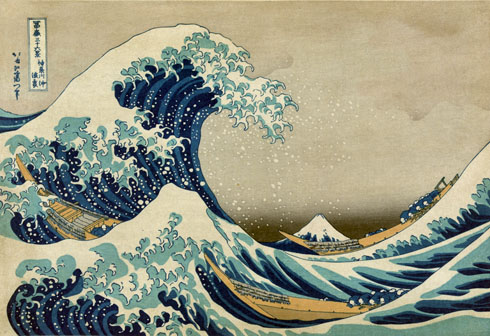History Special 2: About Tetsuzo aka Katsushika Hokusai
I. THE MAN WHO CAUSED THE WAVE The title of the print or the name of its author may be obscure to many, but it is considered the most iconic and internationally recognizable piece of Japanese art, and apart from books or museums, it can be easily seen on souvenirs of all shape and kind. It is commonly known as The Great Wave off Kanagawa, although a more faithful translation would be Under a Wave off Kanagawa. It is one of the 30,000 works produced by Katsushika Hokusai, who lived between 1760 and 1849. He is considered one of Japan's greatest artists, but "Hokusai" is only one of the 30 art names this man used during his life. In his late years, he signed his works as the Old Man Mad about Painting. However, Tokitaro (his childhood name), or Tetsuzo, are probably closer to a Western concept of "given name,". He first used the art name "Hokusai" around 1798, and this was the name he used most extensively, although in several variations and compounds.
II. PENNILESS CELEBRITY The Wave is part of a series of 46 pieces called Thirty-six views of Mount Fuji, published around 1831. The reason why they are called "Thirty-six" but there are 46 of them, is that the release of the first 36 prints proved so successful, that Hokusai made 10 more. In fact, despite some highs and lows, Hokusai was an accomplished artist during his lifetime, with clients from all over Japan, and even from the Dutch concession in Nagasaki. There are even accounts of a live painting performance he made in front of the Shogun, the highest political authority of the nation, who was apparently eager to see the "famous Hokusai" in action. Nevertheless, Hokusai was almost penniless throughout his life because he was reportedly uninterested in money. He wouldn't even open bags with the remunerations for his work, simply handing them to the next creditor.

III. IMPRESSING EUROPE The Wave, and Hokusai's art in general, proved to be highly influential to European artists. French Impressionists and Art Nouveau artists loved Japanese prints, by which they were strongly inspired. Claude Monet had a collection of 231 Japanese ukiyo-e from 36 different artists, mainly Hokusai, Hiroshige and Utamaro. His Jardin à Sainte-Adresse (1866) betrays influence from Sazai Hall at the Temple of Five Hundred Arhats, one of Hokusai's Thirty-six Views, which interestingly is an attempt by Hokusai to apply western-style techniques such as perspective, rather unusual for Japanese art of the time. Claude Debussy was visually inspired by the Wave for his symphonic suite La Mer (The Sea), and the 1905 edition of the score is a straightforward homage to Hokusai's iconic masterpiece.
Throughout his life, Hokusai incessantly tried to improve his art, exploring and experimenting with new techniques. He drew almost everything: portraits, landscapes, animals, still life, erotica, manuals. And still, in his last hour, he is reported to have muttered, "If only Heaven will give me just another ten years..." then he paused briefly, and restarted: "If only Heaven will give me just another five years, then I could become a decent painter."
Hokusai married twice, and had one son and two daughters from each marriage.
The firstborn daughter from his second marriage was named O-Ei.
(fp)
(2 - to be continued)
© Production I.G

![WORK LIST[DETAILS]](/contents/works/design/images/left_title.gif)



 terms of use
terms of use